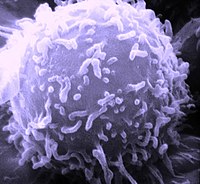
Photo from wikipedia
The T cell repertoire potentially presents complexity compatible, or greater than, that of the human brain. T cell based immune response is involved with practically every part of human physiology,… Click to show full abstract
The T cell repertoire potentially presents complexity compatible, or greater than, that of the human brain. T cell based immune response is involved with practically every part of human physiology, and high-throughput biology needed to follow the T-cell repertoire has made great leaps with the advent of massive parallel sequencing [1]. Nevertheless, tools to handle and observe the dynamics of this complexity have only recently started to emerge [e.g., 2, 3, 4] in parallel with sequencing technologies. Here, we present a network-based view of the dynamics of the T cell repertoire, during the course of mammary tumors development in a mouse model. The transition from the T cell receptor as a feature, to network-based clustering, followed by network-based temporal analyses, provides novel insights to the workings of the system and provides novel tools to observe cancer progression via the perspective of the immune system. The crux of the approach here is at the network-motivated clustering. The purpose of the clustering step is not merely data reduction and exposing structures, but rather to detect hubs, or attractors, within the T cell receptor repertoire that might shed light on the behavior of the immune system as a dynamic network. The Clone-Attractor is in fact an extension of the clone concept, i.e., instead of looking at particular clones we observe the extended clonal network by assigning clusters to graph nodes and edges to adjacent clusters (editing distance metric). Viewing the system as dynamical brings to the fore the notion of an attractors landscape, hence the possibility to chart this space and map the sample state at a given time to a vector in this large space. Based on this representation we applied two different methods to demonstrate its effectiveness in identifying changes in the repertoire that correlate with changes in the phenotype: (1) network analysis of the TCR repertoire in which two measures were calculated and demonstrated the ability to differentiate control from transgenic samples, and, (2) machine learning classifier capable of both stratifying control and trangenic samples, as well as to stratify pre-cancer and cancer samples.
Journal Title: Frontiers in Immunology
Year Published: 2018
Link to full text (if available)
Share on Social Media: Sign Up to like & get
recommendations!